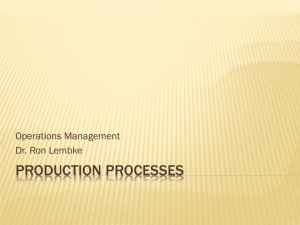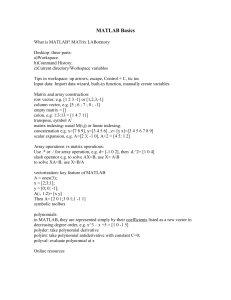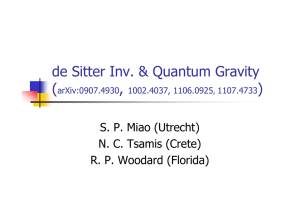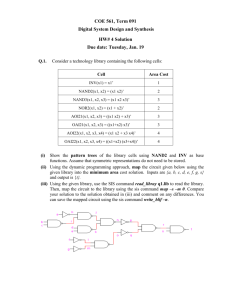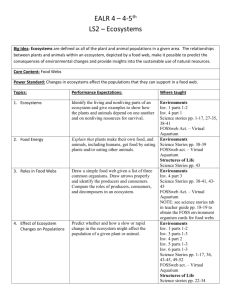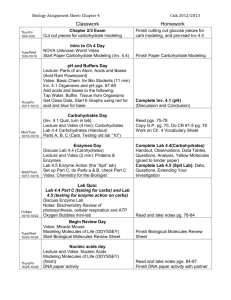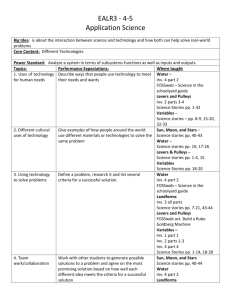A NOTE ON ISOMORPHIC COMMUTATIVE GROUP ALGEBRAS OVER CERTAIN RINGS Peter Danchev
advertisement
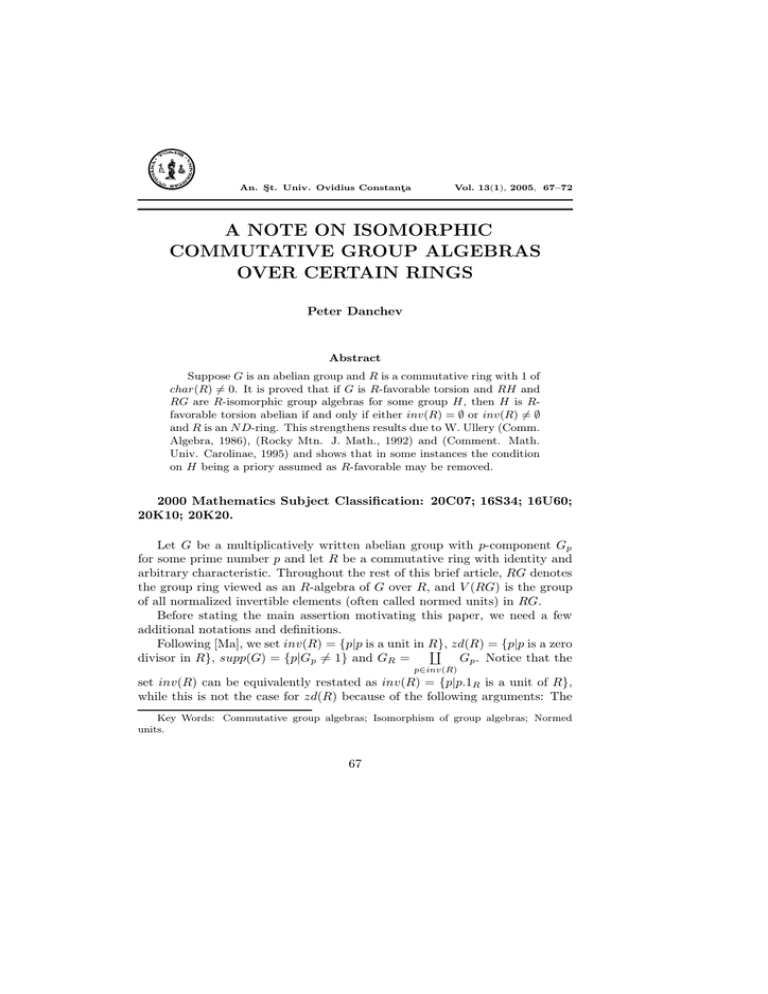
An. Şt. Univ. Ovidius Constanţa
Vol. 13(1), 2005, 67–72
A NOTE ON ISOMORPHIC
COMMUTATIVE GROUP ALGEBRAS
OVER CERTAIN RINGS
Peter Danchev
Abstract
Suppose G is an abelian group and R is a commutative ring with 1 of
char(R) = 0. It is proved that if G is R-favorable torsion and RH and
RG are R-isomorphic group algebras for some group H, then H is Rfavorable torsion abelian if and only if either inv(R) = ∅ or inv(R) = ∅
and R is an N D-ring. This strengthens results due to W. Ullery (Comm.
Algebra, 1986), (Rocky Mtn. J. Math., 1992) and (Comment. Math.
Univ. Carolinae, 1995) and shows that in some instances the condition
on H being a priory assumed as R-favorable may be removed.
2000 Mathematics Subject Classification: 20C07; 16S34; 16U60;
20K10; 20K20.
Let G be a multiplicatively written abelian group with p-component Gp
for some prime number p and let R be a commutative ring with identity and
arbitrary characteristic. Throughout the rest of this brief article, RG denotes
the group ring viewed as an R-algebra of G over R, and V (RG) is the group
of all normalized invertible elements (often called normed units) in RG.
Before stating the main assertion motivating this paper, we need a few
additional notations and definitions.
Following [Ma], we set inv(R) = {p|p is a unit in R},
zd(R) = {p|p is a zero
Gp . Notice that the
divisor in R}, supp(G) = {p|Gp = 1} and GR =
p∈inv(R)
set inv(R) can be equivalently restated as inv(R) = {p|p.1R is a unit of R},
while this is not the case for zd(R) because of the following arguments: The
Key Words: Commutative group algebras; Isomorphism of group algebras; Normed
units.
67
68
Peter Danchev
fact that p.1R is a zero divisor of R implies that p has such a property in R,
that is there exists 0 = r ∈ R with pr = 0, whereas the converse implication
does not hold in general. For example, if F is a field of char(F ) = p > 0, we
have p.1F = 0 whence it is not a zero divisor, but pf = 0 for each 0 = f ∈ F
and so p is a prime zero divisor. Nevertheless, these two claims are equivalent
for rings of characteristic distinct from p.
Definition. ([U], [Ulle]). The abelian group G is called R-favorable when
GR = 1, or equivalently when supp(G) ∩ inv(R) = ∅.
Definition. The commutative ring R with identity is said to be indecomposable if it has no nontrivial idempotents.
Definition. ([U], [Ulle]). The commutative unitary ring R is termed as an
ND-ring (= nicely decomposing) if R can be properly decomposed in the
following manner: R = R1 × · · · × Rn for some natural number n such that
there is an index i: 1 ≤ i ≤ n with inv(R) = inv(Ri ).
By using this definition and some other crucial facts, Ullery obtains the
following necessary and sufficient condition for a commutative unitary ring to
be an N D-ring, namely:
Criterion. ([U]). The commutative ring R with identity is an N D-ring if and
only if there is a homomorphism R → K for some indecomposable commutative
ring K with identity so that inv(R) = inv(K).
The major purpose of the present short note is to check whether or not
the property of G being R-favorable torsion can be inherited by RG and, if
yes, over what rings this remains realized. We settle below this matter in the
affirmative by finding a criterion for any commutative unitary ring equipped
with nonzero characteristic. We terminate the exploration with a problem
concerning the case of rings of zero characteristic.
Before giving the main result and its proof, a few technicalities are in order
(e.g. [Ma], [May] and [U], [Ulle] for nomenclature), namely:
Proposition. (May, 1976). Let R be an indecomposable ring and let supp(G)∩
inv(R) = ∅. If p ∈ inv(R), then Vp (RG) = 1.
It is well-known that any ring homomorphism R → K endows K with the
structure of an R-algebra and thus it ensures the K-isomorphism of algebras
KG ∼
= RG ⊗R K.
According to this isomorphism property and to the preceding May’s statement, Ullery establishes the following assertion.
Theorem. ([U]). Suppose G is an abelian group and R is an N D-ring or an
indecomposable commutative ring with 1. If G is R-favorable and RH ∼
= RG
A NOTE ON ISOMORPHIC
69
as R-algebras for any group H, then H is R-favorable as well. Even more,
H∼
= G provided char(R) = 0.
We shall use and extend in the sequel this affirmation by showing that
for rings of positive characteristic with non-empty set of invertible primes the
N D-rings are the only ones that preserve the property of the torsion group
basis to be ring-favorable. Thus we discover that the complete inheritance by
RG of this property for another group basis H consists entirely of the specific
decomposable ring structure of R.
The next proposition will be helpful for proving once again that the group
G modulo its torsion part Gt , that is G/Gt , can be invariantly retrieved by
RG over any commutative ring R with identity (see [M], [Ma] and [D] for
example).
Proposition. (May, 1976). Suppose that R is an indecomposable ring and
suppose that supp(G) ∩ inv(R) = ∅. Then V (RG) = GWRG and G ∩ WRG =
Gt , where WRG is the multiplicative group (= the group of units) of the maximal integral subalgebra of RG with augmentation 1 and Gt is the maximal
torsion subgroup of G.
This enables us to give our first statement.
Theorem. Suppose R is a commutative ring with identity of char(R) = 0 and
G is a torsion R-favorable abelian group. Then RG ∼
= RH as R-algebras over
R for any group H will imply that H is a torsion R-favorable abelian group if
and only if either 1) inv(R) = ∅ or 2) inv(R) = ∅ and R is an N D-ring.
Proof. We foremost note that G being torsion and RG ∼
= RH being R−isomorphic
force that H is torsion as well (see [M] or [D] for instance).
After this, we consider two cases about inv(R).
1) inv(R) = ∅.
Hence every torsion group is R-favorable, so G and H being torsion groups
are both R-favorable.
2) inv(R) = ∅.
In this aspect, two subcases are valid:
2.1) If R is indecomposable, we mention that it can be formally interpreted
as an N D-ring and everything is done by the foregoing listed result of Ullery
from [U].
2.2) Suppose for a moment that R is decomposable, say R = R1 × · · · × Rn
for some rings Ri , 1 ≤ i ≤ n, n is natural. Notice that RG ∼
= RH ⇐⇒
Ri G ∼
= Ri H, ∀ i : 1 ≤ i ≤ n.
First of all, if R is an N D-ring, we are done (e.g. [U]).
That is why, we shall presume that R is not an N D-ring, whence inv(R) ⊂
inv(Ri ) ∀ i : 1 ≤ i ≤ n. Thus, we distinguish two possibilities for char(R).
Peter Danchev
70
a) Firstly, we note that char(R) = pk , for all primes p and all positive
integers k. Otherwise, char(R) = pk for some prime number p and natural
number k assures that p ∈
/ inv(R) and thus there is l : 1 ≤ l ≤ n with
p∈
/ inv(Rl ); p ∈ inv(Ri )∀i if and only if p ∈ inv(R). But (q, p) = 1 ∀ prime
numbers q = p, so q ∈ inv(R) ⊂ inv(Ri ) ∀i. Therefore inv(R) = π \ {p} =
inv(Rl ), where π is the set of all primes. Henceforth, R is an N D-ring, a
contradiction.
b) Secondly, char(R) = m = pk , for all nonegative integers k and over any
prime number p. We show below that there exist three objects R, G and H,
such that R is not an N D-ring, char(R) = 6 and G is R-favorable while H
is not R-favorable but RG ∼
= RH are R-isomorphic. This will substantiate
our claim that for the group H to be deduced as R-favorable, R must be an
N D-ring.
For a counterexample, let R = F2 × F3 , where Fp is an algebraically closed
field of characteristic p, let Tp be an abelian p-group of cardinality ℵ0 , and put
G = T2 × T3 and H = T2 × T3 × T5 . Furthermore, it follows from well-known
results due to May [M] on group algebras over algebraically closed fields that
F2 T3 ∼
= F2 G × F3 G ∼
=
= F2 (T3 × T5 ) and F3 T2 ∼
= F3 (T2 × T5 ). Thus RG ∼
∼
(F2 T3 )T2 × (F3 T2 )T3 = (F2 (T3 × T5 ))T2 × (F3 (T2 × T5 ))T3 ∼
= F2 (T2 × T3 ×
T5 ) × F3 (T2 × T3 × T5 ) ∼
= (F2 × F3 )(T2 × T3 × T5 ) = RH. So, the example is
shown and the theorem is proved in full generality.
We now examine the extreme case when char(R) = 0 with inv(R) = ∅.
Consider the ring R = P × L where char(P ) = char(L) = 0. Since inv(R) = ∅
it follows that inv(P ) ∩ inv(L) = ∅, and even more that inv(R) ⊆ inv(P ) ∩
inv(L). Note that we can take inv(P ) = inv(L) when R is not an N D-ring.
Next, the following problem is actual.
Problem. Given P = Z[1/p, 1/q] and L = Z[1/p, 1/s] as well as G ∼
=
Z(q ∞ )× Z(s∞ ) and H ∼
= Z(p∞ )× Z(q ∞ )× Z(s∞ ). (We indicate that, because
only p ∈ inv(R), so R is not an N D-ring, G is R-favorable while H is not.)
Does it follow that P G ∼
= P H as P -algebras and LG ∼
= LH as L-algebras,
respectively?
Notice that, because of the symmetry, only the first isomorphism of algebras have to be verified. If this question has a positive answer, we conclude
that RG ∼
= RH as R-algebras. Thereby, when char(R) = 0, the condition on
R to be an N D-ring cannot perhaps be omitted in general as well.
However, that possibility is probably fulfilled in all generality for the mixed
case as the following example shows.
Example. ([U], Theorem 2). When G is mixed, R need not be however an
N D-ring. Specifically, there exist three objects, namely R, G and H, such
A NOTE ON ISOMORPHIC
71
that R is not an N D-ring, char(R) = 0 and inv(R) = ∅ whereas both G and
H are R-favorable mixed groups with RG ∼
H.
= RH. Nevertheless, G ∼
=
It may be given two another independent simple verifications of the periodicity of H.
In fact, if G is torsion and Gp = 1 for every prime p, then G = 1 hence
H = 1 and there is nothing to prove. If now Gp = 1 for some prime number p,
then p ∈ inv(R) since G is R-favorable. Furthermore, there exists a maximal
ideal J of R with p ∈ J. So, F = R/J is a field of char(F ) = p > 0 and
by the tensor multiplication over F , we infer that RG ∼
= RH as R-algebras
guarantees that F G ∼
= F H as F -algebras. Thus [M], [Ma] or [D] can be
employed to derive that H is torsion, as wanted.
For the second confirmation in a special case for G, given that P is a
minimal prime ideal of R, whence R/P is an integral domain and so indecomposable. Besides, we obviously observe that RG ∼
= RH as R-algebras
yields (R/P )G ∼
= (R/P )H as R/P -algebras. We shall assume extraordinary
that G is chosen a priory as R/P -favorable, hence it is R-favorable since
p ∈ inv(R) therefore p ∈ inv(R/P ) whence inv(R) ⊆ inv(R/P ). Without
harm of generality, we shall assume also that (R/P )G = (R/P )H. Since,
by what we have argued above, both G and H are R/P -favorable groups,
whence supp(H) ∩ inv(R/P ) = ∅, consulting with the second proposition of
May we can write V ((R/P )G) = GW(R/P )G = HW(R/P )H = V ((R/P )H).
Because of the fact that the maximal integral subalgebra is an invariant for
the group algebra, we establish that GW(R/P )G /W(R/P )G ∼
= G/Gt ∼
= H/Ht ∼
=
HW(R/P )H /W(R/P )H . Thus G/Gt ∼
= H/Ht and G being torsion trivially leads
us to H is torsion, as desired.
The proofs are finished.
Remarks. W. May ([Ma], p. 489, line 13(-)) had claimed that R1 ≤ R, where
R is indecomposable, implies that inv(R1 ) ⊆ inv(R), but this is not immediate
if it is true or otherwise it holds valid when 1R ∈ R1 ⇐⇒ 1R1 = 1R .
We emphasize that char(R) = p gives p.1R = 0 whence p ∈ inv(R) and
p ∈ zd(R), but char(R) = 0 when zd(R) = ∅.
Moreover, an appeal to the foregoing Theorem riches us with the implication that if char(R) = p = 0 and G is p-mixed, then RH ∼
that H
= RG insures
is p-mixed, too. This is so since in that situation we have GR = q=p Gq = 1.
In the special case when G is also torsion, each R-favorable torsion group is a
p-group.
In the variant when inv(R) coincides with the set of all primes, G being
R-favorable torsion gives that G = GR = 1, and so by combining G = 1 and
RH = RG we elementarily extract that H = 1.
Finally, we comment some aspects from the papers [Ulle] and [Ullery].
72
Peter Danchev
Inspired by the above argued Theorem, we detect that it is not necessarily in
all of the hypotheses in [Ulle] the group H to be a priory given as R-favorable
torsion. In this direction, in [Ullery], H need not be a p-group a priory, because
as we have just seen RG ∼
= RH along with p ∈ inv(R) imply F G ∼
= F H for
some field F of char(F ) = p, whence G being a p-group yields that the same
holds true for H, and besides Gp = 1 ensures Hp = 1. Thereby, it is rather
natural to consider the another possibility for p. So, we state the following.
Problem. If Gp = 1 such that p ∈ inv(R) and RH ∼
= RG, does it follow that
Hp = 1?
The Theorem answers when supp(G) ∩ inv(R) = ∅. This query considers
the reverse cases when for all primes q = p we have Gq = 1 but q ∈ inv(R)
that is q ∈ supp(G) ∩ inv(R), or when for almost all primes q = p we have
Gq = 1 but q ∈ inv(R) such that supp(G) ∩ inv(R) = ∅.
However, such an investigation will be a work of some other appropriate
research study.
References
[1] [D] P. V. Danchev, A new simple proof of the W. May’s claim: F G determines G/G0 ,
Riv. Mat. Univ. Parma, 1 (2002), 69–71.
[2] [M] W. L. May, Invariants for group algebras of abelian groups, Illinois J. Math., 15
(1971), 525–531.
[3] [Ma] W. L. May, Group algebras over finitely generated rings, J. Algebra, 39 (1976),
483–511.
[4] [May] W. L. May, Isomorphism of group algebras, J. Algebra, 40 (1976), 10–18.
[5] [U] W. D. Ullery, Isomorphism of group algebras, Commun. Algebra, (5) 14 (1986),
767–785.
[6] [Ulle] W. D. Ullery, On isomorphism of group algebras of torsion abelian groups, Rocky
Mount. J. Math., (3) 22 (1992), 1111–1122.
[7] [Ullery] W. D. Ullery, A note on group algebras of p-primary abelian groups, Comment.
Math. Univ. Carolinae, (1) 36 (1995), 11–14.
13, General Kutuzov Street
block 7, floor 2, apartment 4,
4003 Plovdiv,
BULGARIA
e-mail: pvdanchev@yahoo.com
